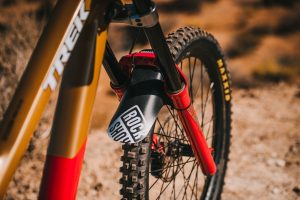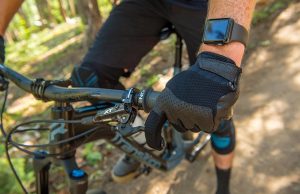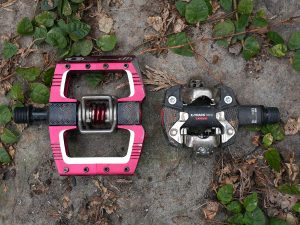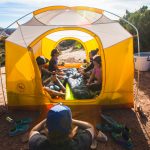Bicycles are a great way to get around and explore the world. They require little maintenance, they’re efficient, and they’re fun – If you want to buy a bike without all the hassle of going store-to-store we recommend checking out this blog post for an extensive guide on how to choose the right bicycle.

Table of Contents
Types of Bikes
Based on your riding style and comfort, you should choose a bike that feels the most natural to ride. Find out more about different types of bikes below:
- Mountain Bikes – If you plan on going offroading or tackling hills we recommend getting a mountain biking bicycle with gears for better traction when riding up and downhill trails.
- Road Bikes – If you plan on going long distances, road bikes are best for speed and efficiency.
- Hybrid Bikes – A mix between a mountain bike and a road bike, perfect if you want the comfortability of a trail while also wanting to take it easy on city streets.
- Cruiser Bicycles – For those who enjoy the curves and look of a classic bicycle. These bikes are perfect for short trips around town, especially if you plan on taking in the sights along the way!
- Ebikes – A great option if you plan on going offroading or tackling hills, these electric bicycles are designed for comfort and efficiency.
- Fitness Bikes – A bike designed with speed and efficiency in mind, perfect if you plan on racing.
- Recumbent Bicycles – An interesting option for those who want to take it easy but still enjoy biking. These bikes are extremely comfortable and great if you have back issues or arthritis
- Tandem Bikes – Great if you want to go for a ride with your partner, or join in on family rides.
Note: These are just a few types of bikes to choose from. If you want more options, check out this guide for an extensive list of bicycle types and styles

Bicycle Frame Material
The type of frame material the bicycle has is also an important factor when choosing which bike to buy. Here are some different types:
- Aluminum – A lightweight and strong metal that can be formed into pretty much any shape, making it a great option for bicycle frames.
- Steel – A classic material, beautiful and durable.
- Carbon Fiber – The lightest option available, carbon fiber is also extremely strong making it great for bike frames as well as bicycles that require high speeds.
- Composite – A mix of materials to create the perfect balance between lightweight durability.
- Steel – A strong and durable metal that is heavy but lasts many years with proper care Material like titanium or carbon fiber may be more expensive than steel, but they also make the bike lighter and stronger.

Handlebar Configuration
There are two types of handlebar configurations available. Here’s a breakdown of each type:
- Drop Bars – This is the traditional option for road bikes, mountain bikes, and touring bicycles. These bars give you more control over your speed as well as allow you to shift gears quickly.
- Straight Bars – These bars are good for commuters and those who enjoy leisurely rides. They’re also great on bumpy terrain because they provide more control over the bike. Plus, since straight handlebars have a flatter surface you can easily rest your hands while riding.

Bicycle Wheels and Tires
The bicycle type you choose will also depend on what kind of tires or wheels it has. Here are some different types:
- Pneumatic Tires – A great option for both road bikes and mountain bikes, pneumatic tires are air-filled cylinders that provide a great deal of cushion making them comfortable to ride on rough surfaces.
- Solid Rubber Tires – A traditional option, these tires are usually found on cruiser bicycles and do not have any shock absorption capabilities. They’re an inexpensive choice but require more effort in order to get moving when riding over bumpy terrain.

Bicycle Gears
As you can imagine, the type of gear a bicycle has is an important factor when choosing which bike to buy. Different types include:
- Single Speed Bikes – These bikes are for those who enjoy riding but aren’t looking for much in terms of speed or efficiency. They’re great if you plan on taking in the sights and going at a leisurely pace.
- Bicycles With Gears – More gears means more speed and efficiency. These bikes are perfect for long distances or racing.
- Bicycles With Hand Brakes – These are traditional braces that are found on most road bikes and mountain bikes, but they’re also the least efficient option for stopping especially in wet conditions.
- Internal Gear Hubs – The only internal gear hub option available, these hubs are low maintenance but require more effort when it comes to shifting gears making them great for commuting or riding on flat surfaces.
- External Gear Hubs – In terms of both speed and efficiency, external gear hubs are best for road bikes. They’re easier to shift than internal gear hubs, making them great if you plan on speeding along the streets.

Type of Suspension
To help you decide which type of suspension is best for your bicycling needs, here’s a list of the three different options available:
- No Suspension – This means there is no shock absorption capabilities on the bicycle. It will be difficult to ride over bumpy terrain and difficult to control as well because this lack of cushioning causes you to bounce as you ride.
- Hardtail – This is a traditional suspension type that has a rigid frame and an attached shock absorber on the front wheel or fork of the bike. It’s great for those who want to be able to take their bikes off-road but don’t have much experience riding mountain bikes due to its lack of shock absorption.
- Full Suspension – Perfect for mountain biking, full-suspension bikes provide the rider with a great deal of control and cushioning making them perfect if you plan on taking your bike over uneven terrain.

Bicycle Brakes
There are three types of brakes available. Here’s a breakdown of each type:
- Rim Brake Systems – Found on most regular bicycles, these brakes are activated by squeezing the brake levers on the handlebar.
- Disc Brake Systems – Found exclusively on mountain bikes, disc brake systems are far more efficient than rim brake systems because they bring both wheels to a complete stop faster. However, this also means that you will need to adjust them or perform maintenance yourself after extended periods of use.
- Foot Brake Bikes – Foot brake bicycles have a break located at the pedal giving it more control over your speed than if it had a traditional break.

Bike Size and Fit Consideration
Bikes come in different sizes. To ensure you buy the right size bike, make sure to take the measurements of your height and leg length into consideration before making a purchase.
- Mounting Point – A traditional mounting point allows you to adjust where the seat sits on the frame, but this may also make for a less comfortable ride as well as affect how fast or efficient your bicycle can be.
- Forward-set Mounting Points – These are found on high-performance bicycles and allow the seat to be placed further forward making it easier for you to reach the pedals while riding. This also provides more control over your speed, but may not work as well if you have back problems.
- Drop Mounting Points – The most popular mounting point choice amongst cyclists because they provide the best of both worlds. These are found on most road bikes and allow you to adjust the seat forward or backward depending on your needs.
- Handlebar Adjustability – The more adjustable a handlebar is, the better it will be able to fit different-sized riders making for a much more comfortable ride overall. However, this also means that they may not be as sturdy or strong.
- Adjustable Stem – This is the ideal option if you are buying a bike for someone who may grow in size, but it isn’t always available on every model of bicycle. It’s important to note that this will affect how efficient your ride can be because having an adjustable stem could introduce more friction into your system.
- Frame Size – The larger the frame is, the heavier your bicycle will be because it needs to support more weight. However, having a bigger surface area also means that there are fewer gaps for wind resistance which makes biking easier overall.
- Wheel Diameter – Larger wheels require more energy and effort on your part when you’re cycling, but they do make it easier to keep your speed. In general, you should choose a wheel with as large of a diameter as possible because this will provide more air resistance which means that you can use less effort when biking and still maintain the same speeds.

Other Considerations
There are a number of other considerations that you need to take into account before buying your bicycle. These include:
- Storage Space – If you can’t store your bike inside, do consider how easy the components will be to remove and clean because this may affect its lifespan if it’s exposed to harsh weather conditions for extended periods of time.
- Safety – If you plan on using your bicycle for professional use where safety is a priority, make sure to choose one that meets the necessary standards.
- Maintenance – How easy will it be to maintain and repair your bike? The more complicated or advanced components are often harder to take care of which can affect how long it lasts before needing repairs.
- Battery Powered – If your bike is battery powered, do consider how often you will need to recharge it and if the batteries are easy to replace when they lose their charge.
- Price – The price is always important, but this shouldn’t be the only factor you consider. Try to find a balance between quality and cost because if your budget is too low it may be hard for you to find the right bike that meets all of your needs
- Weight – This will affect how easy or difficult it is for you to move or transport your bicycle, but this isn’t always something you should base your decision on.
- Form – Consider the overall form of your bicycle before buying it. You may find that some are more comfortable than others which can make a huge difference over time.
- Accessories – If you plan on using your bike for professional use, consider what accessories will help to improve its performance and efficiency such as water bottle holders or mudguards.
- Repair Cost – The more advanced a bicycle model is, the higher its repair costs may be because more components can break or malfunction over time which requires greater technical knowledge for repairs.
- Portability – If storage space can be limited in your home, consider buying a foldable bicycle that can easily be stored in a closet or under your bed.

What to Avoid
It is important to avoid buying a bicycle that doesn’t meet your specific needs. This includes:
- Choosing the wrong size – If you choose a bike that’s too big or small, it can affect how easily and smoothly you ride which may increase the risk of accidents over time.
- Unreliable parts – Balance out cost with quality when looking for a bicycle with reliable components. This includes choosing an electric or battery-powered model that has high-quality batteries and chargers to ensure they last as long as possible before needing replacement which can be costly in the long run.
- Low-quality tires – When you choose your bike, make sure it comes equipped with good rubberized tires because these can make a huge difference for how smoothly you ride.
- Low-quality chains – Similar to tires, good chains can also help your bike perform better and last longer which means they’re worth investing in when buying.
- Cheap brakes – If your bike doesn’t have front or rear brake systems, you should not buy it because this puts the rider in a dangerous position.
- Poor brakes – When it comes time to buy your bicycle, prioritize the model with the most efficient braking system that allows easy control of the bike.
- Poor suspension – If your bike doesn’t have a good suspension system, it can make riding a lot more uncomfortable which may also affect the rider’s ability to control the bicycle.

Question to Ask Yourself Before Buying
- What kind of riding will I be doing?
- How often do I plan on using my bike?
- Do I need to transport or store it regularly and if so, where am I going to put it when not in use?
- Which accessories might improve my biking experience such as mudguards for rainy days?
- Is the repair cost a factor I need to consider?
- What types of tires do the bikes have and how easy are they to replace when worn down?
- What is the weight of the bike and how does this affect its performance?
- Is it easy to fold up for storage when necessary?
- Are there any unreliable parts that may need replacing or fixing regularly depending on use?
- Does my bicycle have a strong suspension system if I plan on taking it off-road often?
- Is my bicycle’s braking system easy to control?
- Does the bike come with good quality chains, tires, and brakes that will withstand use over time?

FAQ
Q: What types of bicycles are there?
A: There are many different types, including mountain bikes, road bikes, BMXs, and electric or battery-powered bicycles.
Q: What should I keep in mind when choosing my bike?
A: A good tip is to consider what you plan on using it for and the most important factors in your decision. This will ensure you buy a model that meets all of your needs so there’s no need to upgrade later.
Q: How much do bicycles usually cost?
A: The average price range can be anywhere from $300 to more than $3000 depending on its features and components, making it hard to estimate an exact figure.
Q: What are the different types of bikes?
A: There are many different types including mountain bikes, road bikes, BMXs, and electric or battery-powered bicycles.
Q: Which factors should I keep in mind when buying my bike?
A: A good tip is to consider what you plan on using it for and the most important factors in your decision. This will ensure you buy a model that meets all of your needs so there’s no need to upgrade later.
Q: Is it better to choose an electric or battery-powered bicycle?
A: This depends on your needs, but if you plan to use it for long periods of time or want better performance, electric bikes are suitable.










